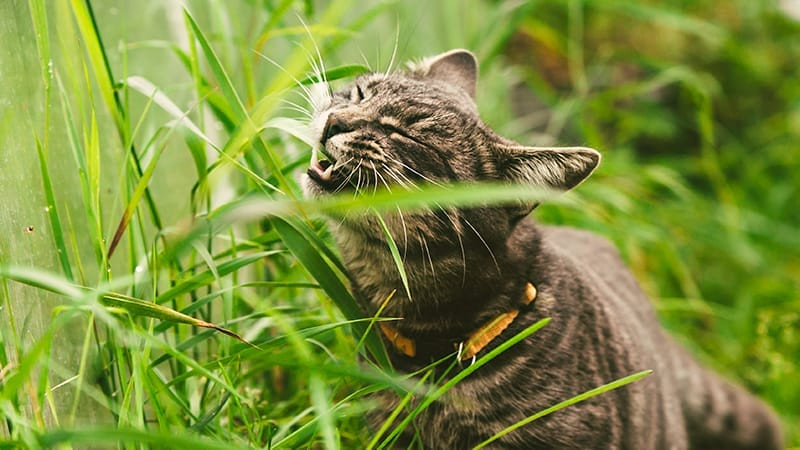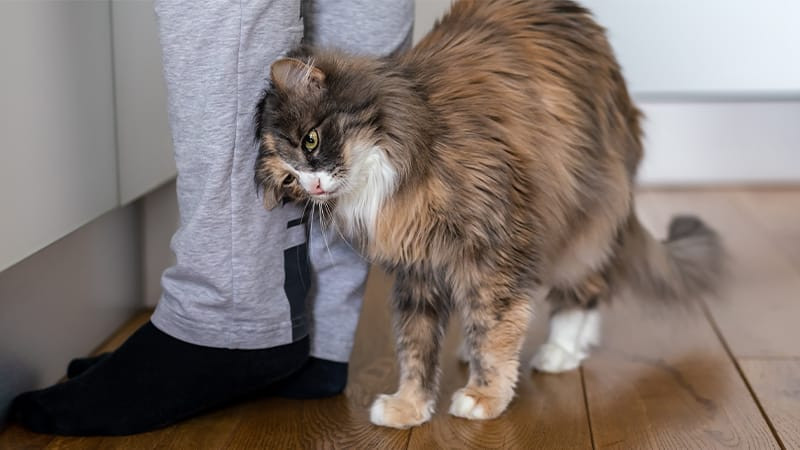Cats, with their enigmatic nature, exhibit a range of behaviors that can often leave their human companions intrigued and occasionally perplexed. By understanding and interpreting these actions, we can forge deeper connections with our feline friends and ensure we are meeting their needs effectively. If you’ve ever wondered about the reasons behind your cat’s quirky habits, delve into this guide as we unravel the mysteries of common Cat Behaviors.
Understanding Physical Cat Behaviors
The Art of Napping
While domesticated cats no longer rely on hunting for survival like their wild ancestors, their ingrained instincts remain. One prominent behavior is their tendency to conserve energy through frequent naps. Cats possess a slightly higher basal body temperature compared to humans, making them naturally inclined to seek out warm spots for resting. You’ll often observe them basking in sunlit areas or curled up on cozy, warm surfaces. This behavior isn’t just about comfort; it’s a biological imperative rooted in their evolutionary history as predators who conserve energy for bursts of hunting activity.
Why Cats Eat Grass
It’s a common sight to see cats nibbling on grass, but what drives this behavior? There are several theories behind this grassy indulgence. For some cats, grass consumption aids digestion by acting as a natural emetic, helping them to expel indigestible materials, including hairballs. For others, it might simply be a palatable snack or a way to satisfy their innate urge to chew. Grass also provides essential nutrients that may be lacking in their regular diet, serving as a supplementary source of vitamins and minerals. However, it’s crucial to ensure that any grass accessible to your cat is free from pesticides and harmful chemicals, as these substances can be toxic to felines.
 Cat Eating Grass – A cat nibbles on fresh green grass in a garden, showcasing a common feline behavior.
Cat Eating Grass – A cat nibbles on fresh green grass in a garden, showcasing a common feline behavior.
Aggression Towards People or Pets
Aggressive behavior in cats can arise from a multitude of underlying causes, including anxiety, fear, territorial instincts, or feelings of being threatened. Creating a secure and enriching environment, coupled with positive reinforcement training techniques, can significantly help in mitigating aggressive tendencies in cats. Understanding the root cause of aggression is key to addressing it effectively, whether it’s fear-based aggression requiring a calmer environment or territorial aggression needing resource management.
The Fascination with Knocking Things Over
Cats possess an inherent curiosity about their surroundings and frequently engage in exploratory behavior, using their paws to investigate and interact with objects. This explains why you might witness them “batting” or nudging items around. When an object moves or rolls in response to their touch, it can trigger their predatory instincts, as they may perceive it as prey attempting to escape, thus initiating a chase. This seemingly mischievous behavior is actually a form of play that allows them to fulfill their natural hunting drives and provides both mental and physical stimulation.
Presenting Gifts: Bringing Items to You
Cats exhibit a deeply ingrained hunting instinct, which sometimes manifests as bringing “gifts” like dead birds, rodents, or insects to their human companions. This behavior is often interpreted as a sign of affection and an indication that they consider their human family as part of their social group or “pack.” By offering these items, cats may be demonstrating their desire to contribute to the group’s well-being, ensuring their humans are “provided for.” This behavior could also be linked to their kittenhood experiences, where their mothers would bring them food and teach them essential hunting skills.
Inappropriate Urination: Outside the Litter Box
Urinating outside the designated litter box or on beds can be a frustrating issue for cat owners. However, this behavior often signals underlying stress or an aversion to their litter box setup. Ensuring your cat has a consistently clean litter box and providing multiple litter boxes in various locations can help alleviate stress-related issues. The type of litter, the box’s location (privacy vs. high traffic), and even the box’s size can all influence a cat’s litter box habits.
It’s also crucial to rule out medical reasons for this behavior. Conditions like urethral obstruction, a life-threatening blockage of the urinary tract, are frequently seen in cats. Symptoms such as increased vocalization, frequent visits to the litter box, straining during urination, or excessive licking of the hindquarters warrant immediate veterinary attention to rule out any underlying medical problems.
The Urge to Scratch
Scratching is an essential behavior for cats, serving multiple purposes. It helps maintain claw health by shedding the outer sheath and keeping them sharp. Scratching also allows cats to stretch their muscles and maintain flexibility. Furthermore, it’s a vital way for them to mark their territory, leaving both visual scratch marks and scent markings through glands located in their paws.
To protect your furniture and other household surfaces, providing appropriate scratching posts or boards is essential. These should be sturdy, tall enough for the cat to fully extend, and ideally covered in materials that mimic natural textures like tree bark or sisal rope. Positioning scratching posts near furniture they are prone to scratch can help redirect their scratching behavior. Regular nail trimming is also beneficial in managing scratching habits and minimizing potential damage.
The Zoomies: Bursts of Energy
The infamous “zoomies” refer to those sudden, energetic bursts where cats sprint around the house, often accompanied by playful antics. This behavior is perfectly normal and serves as a way for cats to release pent-up energy. These bursts of activity are often followed by periods of rest, reflecting their natural cycle of activity and rest.
To positively channel this energy, engage your cat in interactive playtime using toys that mimic prey, such as feather wands or laser pointers. Regular play sessions can help tire them out, provide crucial mental stimulation, and potentially reduce the frequency and intensity of the zoomies.
Self-Care Behaviors Explained
Grooming and Licking: More Than Just Cleanliness
Cats are meticulous groomers, spending a significant portion of their day maintaining their coat. Grooming serves to keep them clean, reducing the need for human-assisted bathing. Licking is also a social behavior; cats lick humans as a sign of affection and bonding. During grooming, cats ingest loose hair, which they typically pass through their digestive system.
However, excessive grooming can be an indicator of stress, anxiety, or underlying medical issues. It can also lead to an accumulation of hair in their gastrointestinal tract, resulting in hairballs. When a hairball becomes large enough and absorbs bile, it triggers a regurgitation response, often characterized by gagging, hacking, or retching sounds followed by vomiting. While occasional hairballs are normal, frequent occurrences or symptoms like loss of appetite, lethargy, constipation, or diarrhea could indicate a potentially dangerous blockage requiring immediate veterinary attention.
 Cat Grooming – A close-up of a cat diligently grooming its fur, highlighting their self-care routines.
Cat Grooming – A close-up of a cat diligently grooming its fur, highlighting their self-care routines.
Decoding Vocal Cat Behaviors
Purring, Meowing, and Hissing: A Symphony of Sounds
Cats employ a diverse range of vocalizations to communicate their needs and emotions. Their vocal repertoire includes meows, hisses, growls, purrs, and chirps, each carrying different meanings. Meowing is primarily used for communication with humans, while hissing and growling typically signal fear, defensiveness, or aggression. Purring is generally associated with contentment and pleasure but can also occur when a cat is in pain or under stress, acting as a self-soothing mechanism. Understanding these vocal cues is essential for effectively responding to your cat’s needs and emotional state.
Nighttime Squalling: Vocalizations in the Dark
Cats often squall or become more vocal at night for several reasons. One primary driver is their natural instinct to mate. When cats are in heat (estrus), they vocalize loudly to attract potential mates, and this calling can be quite persistent and disruptive, particularly at night when it’s quieter.
Another reason for nighttime squalling is attention-seeking behavior. Cats are intelligent and quickly learn that vocalization can elicit attention and care from their owners, such as receiving food or petting. This can lead to a learned behavior where they squall at night to get what they want.
To minimize nighttime squalling, particularly related to mating instincts, keeping your cat indoors, especially at night, can reduce exposure to potential mates. Creating a calming bedroom environment with a nightlight and soothing scents like lavender might also promote more restful sleep for both you and your cat.
However, it’s important to consider potential medical causes for nighttime vocalization, especially in older cats. Age-related conditions like decreased vision or hearing can cause disorientation and anxiety, leading to nighttime squalling as they seek reassurance. Certain health issues such as hyperthyroidism, hypertension, hypokalemia, thiamine deficiency, or intracranial masses can also manifest as increased nighttime vocalization. If you suspect a medical reason for your cat’s nighttime squalling, consulting your veterinarian is crucial for diagnosis and appropriate treatment.
Understanding Body Language Behaviors
Kneading: Paws and Soft Surfaces
Kneading, the rhythmic pushing of paws against soft surfaces, is a common and endearing cat behavior. It’s a sign of contentment, relaxation, and comfort, originating from kittenhood when they kneaded their mother’s mammary glands to stimulate milk flow. In adult cats, kneading persists as a self-soothing behavior and can also be a sign of affection and territorial marking due to scent glands in their paws.
Head Bunting and Rubbing: Scent Marking and Affection
When your cat rubs its head against you or objects around your home, it’s a display of affection and a way of marking territory. Cats have scent glands concentrated on their heads, and by head bunting or rubbing, they are depositing their scent, essentially claiming ownership and showing affection towards you by including you within their scent territory.
 Cat Head Bunting and Rubbing – A cat affectionately rubs its head against a person's leg, demonstrating head bunting behavior.
Cat Head Bunting and Rubbing – A cat affectionately rubs its head against a person's leg, demonstrating head bunting behavior.
Ear and Tail Movements: Visual Cues to Mood
Cats’ highly mobile ears and tails are excellent indicators of their mood and intentions. Forward-pointing ears usually signify attentiveness, curiosity, and focus, indicating they are alert to something in their environment or preparing to pounce. Conversely, flattened or backward ears can signal fear, aggression, discomfort, or defensiveness. A cat’s tail is equally communicative, conveying a wide spectrum of emotions. A relaxed, gently swaying tail typically indicates contentment and relaxation, while an upright, puffed-up tail signals aggression or fear. A flicking or twitching tail can express excitement, anticipation, or agitation, depending on the context and other body language cues.
 Cat Ear Movement – A cat with ears pointed forward, showing attentiveness and alertness through ear position.
Cat Ear Movement – A cat with ears pointed forward, showing attentiveness and alertness through ear position.
Recognizing Signs of Pain in Cats
Identifying pain in cats can be challenging as they are adept at concealing discomfort. Subtle changes in behavior are often the key indicators. If your cat exhibits unusual behaviors like inappropriate urination, aggression, self-mutilation, or other uncharacteristic actions, it could be a sign of underlying pain. Vigilance and awareness of any deviations from their normal behavior patterns are crucial. If you suspect your cat is experiencing pain, prompt consultation with your veterinarian is essential for diagnosis and pain management.
Understanding your cat’s behaviors is fundamental to nurturing a strong and harmonious relationship. By learning to decode their actions, you can better understand their needs, provide appropriate care, and create a supportive and enriching environment for your feline companion. Remember that each cat is an individual, and their behaviors can vary. Observing their body language, vocalizations, and overall demeanor will provide valuable insights into their emotions and well-being. Embrace the rewarding journey of understanding and connecting with your unique feline friend!
For exceptional emergency and specialty veterinary care, find a MedVet near you.

